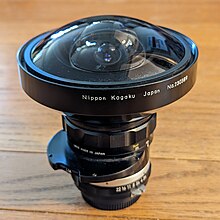
Back Rybí oko Czech Fiskeøjeobjektiv Danish Fischaugenobjektiv German Objetivo ojo de pez Spanish Kalasilm ET Arrain-begi objektibo EU لنز چشمماهی FA Kalansilmä Finnish Objectif fisheye French Lionsa súil éisc GA
 | |
| Introduced in | 1924 |
|---|---|
| Author | Wood (1905),[1] Bond (1922),[2] and Hill (1924)[3] |
| Construction | Var. elements in Var. groups |
A fisheye lens is an ultra wide-angle lens that produces strong visual distortion intended to create a wide panoramic or hemispherical image.[4][5]: 145 Fisheye lenses achieve extremely wide angles of view, well beyond any rectilinear lens. Instead of producing images with straight lines of perspective (rectilinear images), fisheye lenses use a special mapping ("distortion"; for example: equisolid angle, see below), which gives images a characteristic convex non-rectilinear appearance.

The term fisheye was coined in 1906 by American physicist and inventor Robert W. Wood based on how a fish would see an ultrawide hemispherical view from beneath the water (a phenomenon known as Snell's window).[1][5]: 145 Their first practical use was in the 1920s for use in meteorology[3][6] to study cloud formation giving them the name whole-sky lenses. The angle of view of a fisheye lens is usually between 100 and 180 degrees,[4] although lenses covering up to 280 degrees exist (see below). Their focal lengths depend on the film format they are designed for.
Mass-produced fisheye lenses for photography first appeared in the early 1960s[7] and are generally used for their unique, distorted appearance. For the popular 35 mm film format, typical focal lengths of fisheye lenses are 8–10 mm for circular images, and 12–18 mm for diagonal images filling the entire frame. For digital cameras using smaller imagers such as 1/4 in and 1/3 in format CCD or CMOS sensors, the focal length of "miniature" fisheye lenses can be as short as 1–2 mm.
Fisheye lenses also have other applications, such as re-projecting images originally filmed through a fisheye lens, or created via computer-generated graphics, onto hemispherical screens. They are also used for scientific photography, such as recordings of aurora and meteors, and to study plant canopy geometry, and to calculate near-ground solar radiation. In everyday life, they are perhaps most commonly encountered as peephole door viewers to give a wide field of view.
- ^ a b Wood, R. W. (August 1906). "Fish-Eye Views, and Vision under Water". The London, Edinburgh, and Dublin Philosophical Magazine and Journal of Science. 6. XII (LXVIII): 159–161. doi:10.1080/14786440609463529.
- ^ Cite error: The named reference
Bond-1922was invoked but never defined (see the help page). - ^ a b Hill, Robin (July 1924). "A lens for whole sky photographs". Quarterly Journal of the Royal Meteorological Society. 50 (211): 227–235. Bibcode:1924QJRMS..50..227H. doi:10.1002/qj.49705021110.
- ^ a b Henry Horenstein (2005-04-20). Black and White Photography: A Basic Manual. Little, Brown. p. 55. ISBN 9780316373050.
- ^ a b Kingslake, Rudolf (1989). "10. Reversed Telephoto Lenses". A History of the Photographic Lens. San Diego: Academic Press. pp. 141–152. ISBN 0-12-408640-3. Retrieved 10 January 2025.
- ^ David Brooks (1982). Lenses and lens accessories: a photographer's guide. p. 29. ISBN 9780930764340.
- ^ Stafford, Simon; Hillebrand, Rudi; Hauschild, Hans-Joachim (2004). The New Nikon Compendium. Lark Books. pp. 209–210. ISBN 1-57990-592-7.